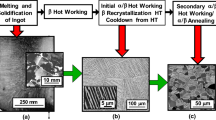Conclusions
-
1.
For structural titanium alloys there are minimal stresses below which the stress does not decrease at a given annealing temperature. The original residual stresses determine the annealing time but do not affect the value of the retained stress.
-
2.
The relaxation resistance of alloys with a coarse-grained structure is 10–35% higher than for alloys with a fine-grained structure at the temperatures tested. More intensive annealing is required to remove residual stresses in weldments than in material with a fine-grained structure.
-
3.
The relaxation resistance increases with increasing stability and decreasing extent to which the structure is heterophase. Other conditions being equal, the relaxation capacity is highest for heterophase titanium alloys of the VT22 type, with a substantial quantity of unstable βM phase.
-
4.
As much as 50–75% of the original stress is removed in the heating stage during annealing under the conditions tested. The heating rate has a considerable effect on stress relaxation.
-
5.
Annealing of alloys OT4-1, VT5-1, and VT22, respectively, at 600–650°, 750–800°, and 650–675° for 0.5–1 h and zonal induction annealing of weldments at 650° for 3–10 min, 800° for 10 min, and 700° for 5 min provide almost complete elimination of residual stress.
Similar content being viewed by others
Literature cited
I. A. Povarov and E. A. Borisova, "Oxidation-free zonal induction heat treatment of weldments in titanium alloys," in: Reports of the Third International Conference on Titanium: Titanium. Metal Science and Technology [in Russian], VILS, Moscow (1976), p. 239.
I. A. Povarov, Method of Determining the Mechanical Properties of a Material in Heat-Affected Zones of Welds [in Russian], Informatsionnyi Listok No. 74-2179, VIMI, Moscow (1974).
A. M. Borzdyka and L. B. Getsev, Stress Relaxation in Metals and Alloys [in Russian], Metallurgiya, Moscow (1978), p. 256.
T. I. Volkova, "Analysis of results from stress relaxation tests by different methods," in: Structure and Properties of Heat Resistant Materials [in Russian], Mashgiz, Moscow (1959), p. 225.
I. A. Oding and T. I. Volkova, "Limit of stress relaxation," in: Relaxation and Creep [in Russian], Mashgiz, Moscow (1952), p. 5.
S. G. Glazunov and V. N. Moiseev, Structural Titanium Alloys [in Russian], Metallurgiya, Moscow (1974), p. 367.
G. I. Arkavenko, N. A. Grekov, and N. F. Lyapicheva, "Stress relaxation in titanium alloys as a function of hot deformation conditions," Metalloved. Term. Obrab. Met., No. 3, 60 (1966).
S. Z. Bokshtein et al., Izv. Akad. Nauk SSSR, Met., No. 5, 210 (1971).
Additional information
Translated from Metallovedenie i Termicheskaya Obrabotka Metallov, No. 6, pp. 42–46, June, 1980.
Rights and permissions
About this article
Cite this article
Povarov, I.A. Stress relaxation in structural titanium alloys. Met Sci Heat Treat 22, 433–438 (1980). https://doi.org/10.1007/BF00693650
Issue Date:
DOI: https://doi.org/10.1007/BF00693650




